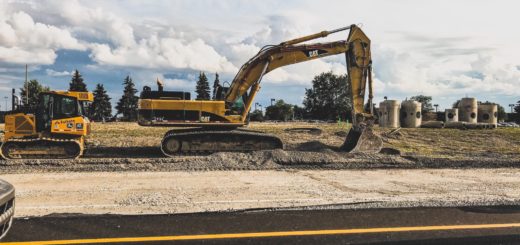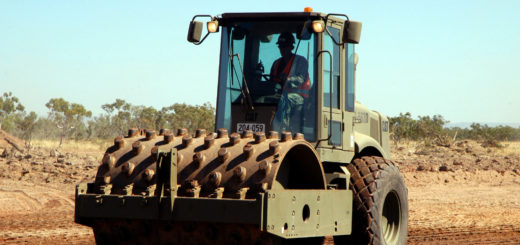5 Methods of In-Situ (Field) Geotechnical Testing
There are many different geotechnical testing methods available. In this article I will list 5 common field tests and provide a brief overview of each. You can find more in-depth information by clicking on the header of each method.
1. Nuclear Density Gauge
The nuclear density gauge or nuclear densometer is the industry standard for quickly and accurately determining the density, moisture content and air voids of a soil. This tool is one of the most common forms of geotechnical testing. The technician will need a sample of the soil being compacted beforehand so a Proctor density test can be performed. The Proctor density test determines a soil’s optimum moisture content that results in the soil’s maximum dry density or Standard Proctor Maximum Dry Density (SPMDD). A percentage of the soil’s maximum dry density is provided by the design engineer, commonly 98% of SPMDD is used.
A nuclear density gauge can be used on any type of subgrade except clean gravels. In direct transmission mode, the pin is driven into the soil and the source rod is lowered into the hole. Take care to ensure that the surface the gauge is placed on is as flat as possible to achieve accurate results. For soils containing high percentages of gravels it is sometimes preferable to use backscatter mode. In backscatter mode the technician does not drive the pin into the ground. While direct transmission mode does provide more accurate data, the driving of the pin into a high gravel content soil can disturb the interlocking gravels of some materials, which can negatively affect the compaction test.

2. Bearing Probe
A bearing probe or hand probe is a tool used by geotechnical engineers to roughly assess the bearing capacity of near surface soils. Bearing probes should not be the only tool used to assess soils on a site and should be used in conjunction with methods of investigation such as drilling, standard penetration tests (SPTs), and nuclear densometer testing. A bearing probe is however a useful final check on native subgrades to ensure bearing capacity before foundations are constructed.
Commonly a bearing probe is simply rebar welded into a T shape. The tester places then nose of the T on the soil he wishes to assess and pushes into the soil at a constant pressure. By doing this he can feel irregularities in the soil, roughly assess its density, detect voids, and detect soft or uncompacted fills.
More advanced bearing probes operate pneumatically with a sliding tip on the nose of the probe that increases the pressure within the probe, providing the tester with a reading correlating to the bearing capacity of the soil that the nose is currently moving through. These types of probes are usually calibrated by the manufacturer and may require calculation to convert the probe reading to the actual bearing capacity of the soil. A pneumatic bearing probe is a much more reliable form of assessing soil as it gives a measurement that can allow an inexperienced tester to still provide a reliable result.
3. Vane Shear Test
The shear vane device is a metal rod with four thin metal blades welded orthogonally (at 90 degree angles to each other). After a borehole is drilled to the desired depth the vane shear device is pushed into the soil and rotated. The vane shear test can only be performed on saturated cohesive soils and is used to find the undrained shear strength. While there are some drawbacks to the vane shear test, it is a simple, inexpensive and simple to perform test that can be completed quickly by trained individuals.
4. Standard Penetration Test
The standard penetration test (commonly refered to as SPT) is the most popular investigative field test. During a geotechnical investigation wherein boreholes are being drilled, the SPT should be performed at regular intervals throughout the depth of every borehole. The SPT provides an indication of soil shear strength where it is performed and allows the extraction of relatively (compared to auger samples) undisturbed samples.
During the drilling of the borehole, an SPT is performed (usually every time another auger must be added) by lowering a rod with a split spoon sampler at its end into the borehole. The end of the split spoon sampler is driven into the soil at the desired depth in three increments of 150 mm by dropping a hammer of standard weight from a standard height on the top of the rod. The first increment, sometimes referred to the “seating increment” is performed to drive the sampler through any slough at the bottom of the borehole and into the undisturbed soil below. The second and third increments are then performed and the number of blows are recorded for each increment. The number of blows is then added together for the second and third increments. The sum of these numbers is referred to as the N-value of the soil at that depth. Many correlations of soil parameters and N-values exist, although some are weak. The most common correlations are the bearing capacity, undrained shear strength and relative density.
5. Cone Penetrometer Test
The cone penetrometer test (CPT) is another popular investigative field test. A rod with an instrumented cone attached to the bottom end is pushed into the soil at a constant rate. The outer wall of the rod is surrounded by a sleeve which allows the cone to penetrate the soil without being impeded by friction between the inner rod and the soil. This allows for more accurate measurement of the end resistance. The cone penetrometer test is a quick to perform test that produces results that are more accurate than the SPT and is less prone to error due to its more controlled nature, however more advanced models of CPT require specialists to run the test and to interpret the data. There are different variations of the CPT that rely on the instrumentation of the cone. Some cones are instrumented to record seismic waves caused by hammers on the surface of the ground (SCPT, or Seismic CPT), others have tiny cameras that allow the identification of soils as the cone is advanced through the soils (VisCPT) or the uCPT test which contains porous material that allows for the measurement of pore water pressure.


